PROJECTS
Contact Tanks
Water storage, treatment and disinfection are frequently modelled with CFD. The calculation of contact time from first principles; identifying the existence of (and eliminating) short circuiting and quantifying t10 values are obligatory requirements for potable water distribution networks.
The Fluid Group were involved with a project upgrading the drinking water treatment plant at Restormel WTW for South West Water. For further details, click here


Reservoirs
Optimising reservoir flow is important. Poor mixing in service reservoirs can result in short circuiting or stagnant areas, which can lead to bacteriological failure in the network.
In larger bodies of water, wind shear or stratification are important, as these affect the distribution of flow from water sources in the area.
The Fluid Group have modelled over 100 reservoirs in the past six years, including proposed new abstraction sources in the Thames Valley area and multiple upgrades to existing water storage structures. The figures here show an upgrade for Wendron WTW.


Spillways
A sudden discharge down a spillway chute is a dramatic event which can be accurately simulated with CFD.
The Fluid Group modelled the Kennick, Tottiford and Trenchford (KTT) Spillways in Dartmoor National Park, and animation of one of those discharge scenarios is shown on the right.
A report of the KTT project and its particular challenges can be downloaded here.
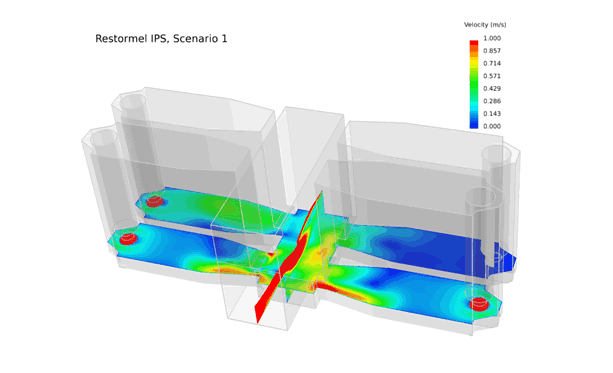
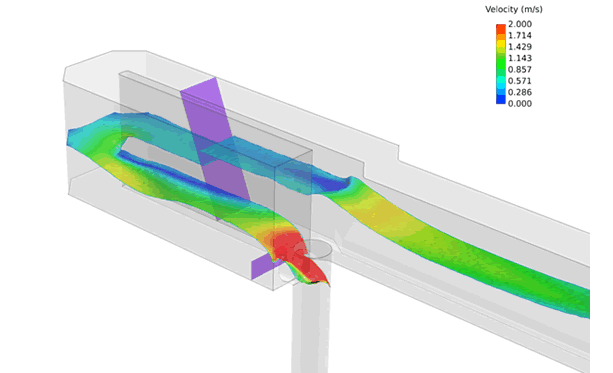
Inlet Works & Pumping Stations
From ensuring that multiple flows mix within a single sump, to analysing grit settlement (low velocity areas), inlet works and pumping stations have been routinely modelled by The Fluid Group.
Predicting cavitation from first principles or identifying the location of vortices within a chamber, CFD is a cost effective analysis technique for comparing new designs or confirming an upgrade to an existing structure.
The Fluid Group have modelled a range of inlet works and pumping stations in the UK and Ireland. For further information click here


Digesters
Modelling non-Newtonian flow (or complex rheologies) is an ideal application for fluid dynamics. Modelling is used to identify poor mixing; to maximise methane production; to compare future designs or upgrades and optimise performance.
CFD modellng within digesters is an increasingly common requirement for businesses wishing to maximise renewable energy production.
It has also been applied to a wide range of renewable energy projects, generating usable power from waste.


Clarifiers
Accurate simulation of clarification processes requires a complex understanding of flow and solids settlement (discrete, hindered, flocculation and compression).
CFD modellng has led the way with improving our understanding of clarifiers in a variety of industries (pharmaceutical, paper, nuclear) and this has extended to detailed multiphase modelling to all aspects of solids in a liquid environment, from fluidised beds to food processing.
An example can be downloaded here. Other examples include primary clarifiers for paper mill waste (where density fluctuations due to temperature were paramount - shown on the right) and flow within rectangular tanks, or flocculation zones.
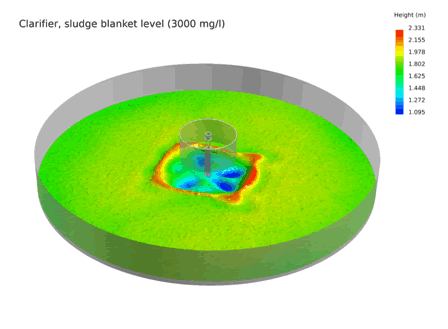
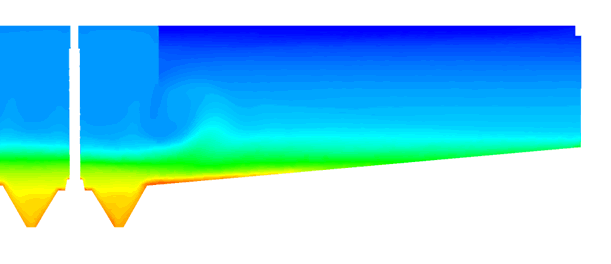
Drop Shafts
The transfer of waste from a high level to a low level sewer often requires the construction of drop shafts.
This requires multiphase modelling, over a range of flow rates and provides an assessment of impact forces, solids and fluid transfer into an existing flow.
The Fluid Group have been involved with the design of a range of new subsurface flow structures in Dubai and Abu Dhabi in the UAE.
Contact us to discuss this project and more.
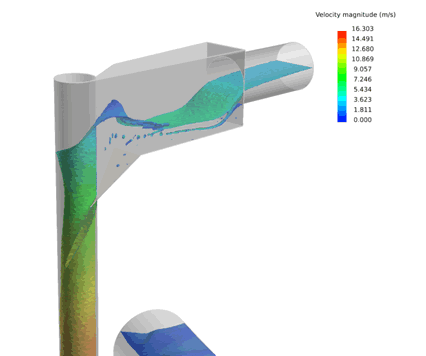
Upflow distribution
Creating an even flow up through a packed or fluidised bed or filter is essential throughout many engineering designs.
The image here is a model of an inlet pipe manifold with multiple nozzles which, through iteration, were eventually designed to provide a homogenous upflow profile.



Dissolved Air Flotation
A great deal of information to aid the design of a dissolved air flotation (DAF) plant can be gained from CFD with multiphase simulation.
Turbidity can be predicted from first principles (Amato & Wicks, J. Wat. Supply (2009) 58, 65-73). Also, the white water level within the tank can be predicted; the point at which excess air would leave a tank and optimisation of maximum flow rates, air flow, recycle rates and structural features such as an inclined baffle height and location can be analysed before construction.

Modelling blood flow and magnetic fields
Magnetically targeted drug delivery is an expanding area of healthcare, where nanoparticles containing iron, for instance, are added to the drug in solution. When they are injected into the patient, the application of an external magnetic field ensures the drug can be delivered directly to the site of interest, rather than potentially damaging other areas of the body, increasing the effectiveness of existing treatments for cancer or diabetes.
The Fluid Group routinely model blood flow (a non-Newtonian fluid), adding patient specific data where necessary (including dynamic blood flow conditions) and have the ability to add external magnetic fields (static and time-varying) while analysing the ability of the nanotechnology to retain chemicals close to the site of interest.

